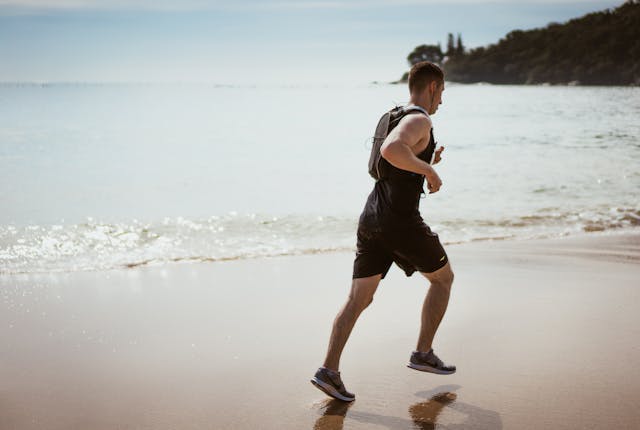Your cart is currently empty!

Running Through the Seasons: Conquering the Elements All Year Round

Runners are a dedicated breed. Rain or shine, scorching sun or biting wind, they lace up their shoes and hit the pavement (or trail) with unwavering determination. But let’s face it, traversing the seasons presents unique challenges. The blistering heat of summer demands a different approach than the crisp, invigorating air of winter. To maintain a consistent and enjoyable running program year-round, here are some essential tips on running through the seasons:
Summer Sizzle: Beating the Heat
Hydration is your hero during the hot summer months. Prioritize increased fluid intake before, during, and after your run. Consider electrolyte-enhanced beverages to replenish lost minerals through sweat. Carry a handheld water bottle or hydration pack for easy access on the go.
Gear Up for the Sun:
- Lightweight and breathable clothing: Choose fabrics that wick away sweat, keeping you cool and comfortable. Opt for light-colored clothing to reflect sunlight and minimize heat absorption.
- Sun protection: Shield yourself from harmful UV rays with a hat and sunglasses. Look for hats with moisture-wicking materials and wide brims for optimal coverage.
Schedule Savvy:
- Cooler hours: Plan your runs for early mornings or evenings to avoid the peak heat of the day. Cooler temperatures allow you to push yourself further and enjoy your run more.
- Shady routes: Seek out shaded routes whenever possible. Parks with ample tree cover or paths alongside buildings offer welcome relief from the relentless sun.
- Pace adjustment: During excessively hot days, adjust your pace and opt for shorter distances. Pushing yourself too hard in extreme heat can lead to heatstroke or exhaustion.
Winter Wonderland: Embracing the Chill
Layer Up Wisely:
- Moisture-wicking base layer: This layer traps your body heat while wicking away sweat to keep you dry and comfortable. Opt for materials like merino wool or synthetic fabrics.
- Insulating mid-layers: Add insulating mid-layers like fleece or wool for warmth. The thickness of this layer will depend on the severity of the cold weather.
- Windproof and water-resistant outer layer: Shield yourself from wind, rain, or snow with a outer layer. Look for breathable materials that allow some moisture to escape while keeping you warm and dry.
Traction Matters:
- Shoes with good tread: Invest in shoes with aggressive tread patterns for better grip on icy or snowy surfaces. These treads provide traction and stability, preventing slips and falls.
- Traction devices: Consider additional traction devices like Yaktrax for extra stability on particularly slippery terrain. These temporary attachments offer peace of mind while navigating icy conditions.
Mind the Cold:
- Exposed skin protection: Protect your face, ears, and hands with a hat, gloves, and a face mask to prevent frostbite. Look for materials that wick away moisture to avoid a buildup of sweat under your layers.
- Thorough warm-up: Before venturing out into the cold, perform a thorough warm-up routine to increase your body temperature and prepare your muscles for activity. This helps prevent injuries caused by cold and stiff muscles.
- Hypothermia awareness: Be aware of the risk of hypothermia during extreme cold. Monitor how you’re feeling and adjust your run duration accordingly. If you experience any signs of hypothermia, seek shelter immediately.
Running Through the Seasons Training Tips
Listen to Your Body:
- Warning signs: Pay close attention to your body’s warning signs. If you experience symptoms of heatstroke or hypothermia, stop running and seek shelter immediately.
- Intensity adjustment: Adjust your training intensity based on how you feel. Don’t push yourself too hard in harsh weather conditions. Listen to your body and prioritize safety over achieving a specific distance or pace.
Gradual Transitions:
- Adding layers: When transitioning from hot to cold weather, gradually add layers to your running attire over a few days. This allows your body to adjust to the changing temperature more comfortably.
- Decreasing layers: Conversely, as the weather warms up, slowly decrease layers to avoid overheating. Start by removing your outer layer and adjust based on your comfort level.
Embrace the Variety:
- Treadmill sessions: During extreme weather conditions, incorporate treadmill sessions into your routine to maintain your fitness level. This allows you to run comfortably in a controlled environment.
- Indoor options: Explore indoor running tracks or consider cross-training activities like swimming or cycling. These activities offer alternative ways to stay active when outdoor running becomes unpleasant or unsafe.
Remember: Safety is paramount. By adapting your training and taking precautions for the specific weather conditions, you can ensure that your running routine thrives throughout the year. So lace up your shoes, embrace the changing seasons, and enjoy the invigorating experience of running through the seasons.

Leave a Reply